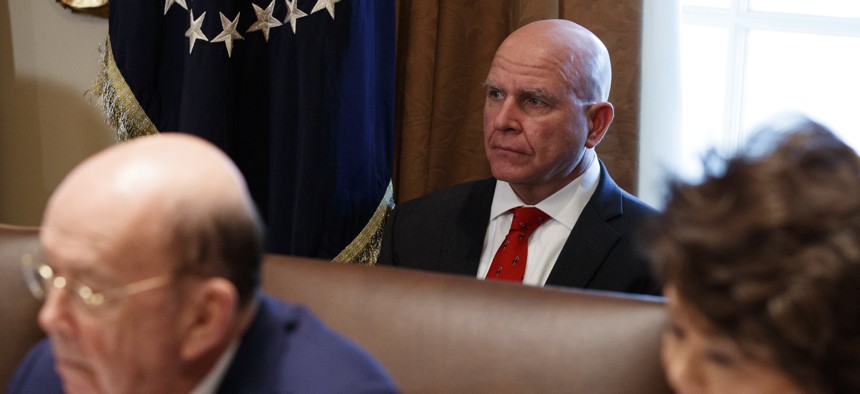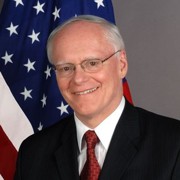
National Security Adviser H.R. McMaster listens as President Donald Trump speaks during a cabinet meeting at the White House, Dec. 20, 2017, in Washington. Evan Vucci/AP
What if H.R. McMaster Is Right About North Korea?
It’s reassuring to think the country wants only a defensive capability. It could very easily be wrong.
In the increasingly urgent, dramatic debate about the North Korean nuclear threat, National Security Adviser H.R. McMaster stands out in the Trump administration as the strongest advocate of a hawkish position. But where do H.R. McMaster’s views on North Korea really come from? Why, to pose a question The Atlantic’s Uri Friedman recently did, is he so worried about North Korea? Notwithstanding the suggestion, in Friedman’s piece and elsewhere, that McMaster’s views represent some kind of heresy of nuclear deterrence, his worries must be seen in light of how he views Kim’s motives. Indeed, those motives mean the possibility of military action against North Korea could be understood not as a “good thing,” but as the “least bad.”
McMaster explained to Chris Wallace on Fox in December that Kim Jong Un’s quest to hold the U.S. mainland at nuclear risk with his ICBM program could well be to advance his goal of conquering South Korea. North Korea’s intentions, he said, “are to use that weapon for nuclear blackmail, and then, to, quote … ‘reunify’ the peninsula under the red banner … and to drive the States and our allies away from this peninsula that he would then try to dominate.”
The problem is that conventional wisdom on North Korea contradicts McMaster, holding that North Korea seeks nuclear weapons primarily to deter an American attack, nuclear or otherwise. (As John Nagl tells Friedman: “I see North Korea pursuing a defensive mechanism to preserve its regime.”) One reason for the popularity of this point of view—that, in a common formula, Kim “doesn’t want to be the next Saddam—is that it is reassuring. And if it is accurate, then absent an invasion of North Korea, Kim will have no reason to use his nuclear (or impressive conventional) arsenal against anyone.
But no one in his or her right mind would invade North Korea. While irrationalities associated with the North Korean regime—and perhaps, in the regime’s analysis, with President Trump—could raise the question of whether Pyongyang recognizes this, the U.S. has signaled repeatedly over decades that it does not want a confrontation, let alone a war. America has dramatically reduced its ground troops on the peninsula; it has withdrawn tactical nuclear weapons from South Korea; and it has engaged in repeated negotiation efforts. And the North Korean quest for missiles that can hit the U.S. far predates the Trump presidency. Furthermore, everyone in leadership on both sides also knows the background. The last U.S. invasion, in October 1950, provoked Chinese military intervention and the biggest battlefield defeat the U.S. Army ever suffered. Even without nuclear systems able to hit the U.S., Kim’s nuclear and huge conventional arsenal suffices to deter any invasion.
But if his goal is to conquer the South, holding the U.S. as nuclear hostage gives him a strategic advantage that threatening Seoul with conventional artillery would not. Moreover, conquest is less phantasmagorical than it appears. Unification on its terms has long been the official policy of Pyongyang (and of South Korea, but it does little to advance it), and it is not just theory—Kim’s grandfather, Kim Il Sung, sacrificed perhaps a million Koreans for that end in the1950 invasion. The Washington that sneers at such a scenario once doubted that North Vietnam, with a political system similar to North Korea’s, would sacrifice even more to unify with its south.
The “book” on how to deal with threats that may not be susceptible to classic nuclear deterrence was written during the Cold War, and McMaster is applying, not ignoring it. In the classic model, both sides have sufficient nuclear systems to survive another side’s first strike and retaliate with a second strike—so launching a nuclear attack is suicide. This, for example, is the decade-long U.S.-China nuclear posture, but it’s insufficient to reliably deter war when real or perceived conventional superiority and aggressive intent are also in play. The USSR after World War II initially sought nuclear weapons as deterrence, but also maintained massive conventional forces in Eastern Europe to keep open the option of conquering Western Europe. The U.S. had pulled its ground troops almost entirely out after 1945, and President Dwight Eisenhower, leery of breaking the bank on a huge peacetime American ground force in distant central Europe, decided on a strategy of massive retaliation—the U.S. would respond not with tanks but nuclear weapons to an invasion.
But by the 1960s the Soviets could hold the American homeland under nuclear threat. This raised the question: Would Americans sacrifice their own cities to save European? Equally important, would its allies believe they would? French President Charles De Gaulle famously did not. Kennedy saw this threat and increased U.S. ground forces, but could not hope to match Soviet forces. So the U.S. remained focused on an “automatic” escalatory ladder beginning with tactical nuclear weapons deployed at the front, many under “dual key” arrangements with nato allies (meaning that the use of tactical nuclear weapons, deployed to alliance members like Germany or Turkey, had to be approved both by the U.S. and the ally in question, further complicating Soviet calculations). In any conflict, such weapons in the middle of a chaotic battlefield, some partially controlled by countries facing extinction, inherently contained a huge risk of a nuclear spiral even if the U.S. didn’t want a global nuclear war. But the planners sought precisely to maintain such a credible “balance of terror” despite the vulnerability of the U.S. homeland.
This same conundrum applies to a North Korea intent on conquering the South through direct invasion or political threat. Once North Korea can strike the U.S., the willingness of Washington to come to Seoul’s defense would be called into question as during the Cold War. As Mira Rapp-Hooper put it to Friedman in another piece, would the U.S. risk Seattle to defend Seoul? The prospect would force the U.S. to choose one of three unpalatable options: fail to come to South Korea’s defense, thereby abandoning 80 years of global collective security; come to its defense and risk killing a huge number of Americans if Kim isn’t bluffing; or watch China intervene to “check” Pyongyang, thereby pulling South Korea (and Japan) into China’s security orbit and ending the security regime the U.S. has maintained in the Pacific since 1945.
Given these alternatives, a preemptive strike (or generating a credible threat of one to frighten China to act against Pyongyang), however awful, could be the least risky choice.
McMaster could be wrong about Kim’s motives, even if they arguably best explain his ICBMs and fit the regime’s history and ideology. But it’s not surprising that he considers this possibility; what is surprising is how much of the American security community dismisses out of hand this explanation for Kim’s risky, costly missile program to target the U.S.
The failure to countenance this possibility could well reflect the historic tendency of liberal societies to discount existential threats simply because they are terrible: The arguments before 1914 that global integration ruled out an extended world war; the appeasement of the Axis powers in the 1930s; and the blinders toward Soviet aggression immediately after World War II.
Taking this possibility into account, as McMaster has, does not necessarily mean embracing preventive war. But it would justify far more risky Cold War-style military preparations, including redeployment of battlefield nukes in or near Korea, and encouraging the development of Japanese and South Korean long-range conventional strike capabilities or, in extremis, their own nuclear capabilities. The aim would be to affect both North Korean and Chinese calculations and introduce automaticity—an almost unstoppable escalation toward a nuclear exchange once any conflict begins—and thus credibility to deterrence.
Furthermore, such risky military preparations would allow Washington to balance them, without appearing to appease Pyongyang, with more realistic, compromise political goals that give North Korea (and China) diplomatic “outs.” These could include a “temporary” diplomatic solution that stops North Korean development of systems that can strike the U.S., but accepts in practice some nuclear capability, rather than the unrealistic maximalist U.S. position of no nuclear weapons. If McMaster can spark such a discussion, the shiver down our spines is worth it.




